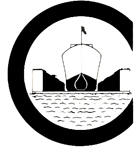Over 150 years of expertise in marine railways and floating dry docks
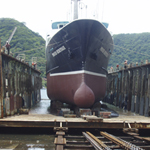 |
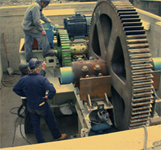 |
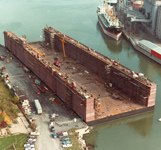 |
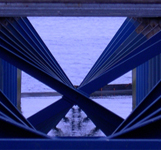 |
|
An
Introduction to Railway Dry Docks
and Transfer Systems
Part
2 - The Basics of Dry Docks
|
3. Side haul railway dry docks |
The railway dry dock differs from both the floating dry dock and the basin or graving dry dock in that it is a mechanical means of hoisting a ship out of water to an elevation above the highest tides, where it rests on a structure fixed to the ground. The vertical lift is similar except that its platform is not supported directly by the ground. The railway has a cradle that is lowered into the water along an inclined track until the vessel to be drydocked can be floated over it. The cradle is then hauled up the track with the vessel, which grounds out on suitable blocks, until the cradle deck is clear of the water. The cradle is designed to support the docked vessel and to distribute its weight to the track. The track must be constructed with a smooth gradient and supported by an adequate foundation. The track and foundation provide the basic support of the cradle at all times. If the ship exerts heavy load concentrations, these are transmitted directly to the track and foundation by the cradle. Therefore the foundation, track, roller or wheel system, and cradle structure must be designed to take the highest expected concentration of load. In a railway dry dock, the line of the keel blocks can be different from the line of the track so as to conform to the more common trim of vessels. Thus, the slope of the track may be gentle or steep to suit local conditions, yet the vessels are lifted on practically an even keel. The declivity of the track may vary from one in two to one in thirty, depending on site conditions, available space, river or tidal currents, variations in water level, and desired lifting capacity. A major improvement was the development of track constructed on a vertical circular curve so as to cause the cradle to rotate as it travels from outshore to inshore. This rotation makes it possible for the keel blocks and cradle deck to be on a declivity when submerged and horizontal in the up position, for ease of side or end transfer. In a few instances, all of the characteristics and restrictions dovetail naturally. The railways at Boulogne-sur-Mer, France, have curved tracks which are steep at the outshore end because they have limited longitudinal space and limited water depth at high tide; an important fraction of the vessels of interest there draw much more water aft than forward. It is very important when lifting a ship out of water that the top of the keel blocks be close to parallel to the ship's keel when contact is made; otherwise tipping forces develop which, in severe cases, could make the ship unstable. The sequence of events in drydocking is that first the vessel is firmly grounded on keel blocks; then while it is still largely waterborne, the bilge supports are placed against the hull, after which the cradle is pulled inshore, making all of the vessel accessible. Hauling up the inclined track is accomplished by means of powerful machinery and chains, which pull the cradle with its superimposed vessel on a system of free rollers or wheels. The speed and economy of this operation represent an advantage of railway dry docks over other systems. The hauling machine and chains are sensitive only to the total live and dead load and to friction associated with the rollers or wheels. When more than one chain is used, the chain loading must be equalized to assure that no single chain is overstressed because of variation in chain pitch. Railway dry dock cradles are of three types of construction: all wood, composite, and steel. In the composite type the cradle superstructure is steel, with the transverse beams, deck, docking platforms, and blocks of wood; in the steel cradle, only the deck and blocks are wood. Most new cradles are steel. Of whichever type, the cradle is a structure of unique design in that it must have strength and stability and yet at the same time by flexible in longitudinal bending and in torsion to accommodate the irregularities of the track and the ship. Tracks may be of the two-, three-, or four-way type. Usually the portion above water is concrete; the submerged portion used to be timber, effectively protected against marine borers as necessary, but nowadays, for cost reasons, steel tracks are more and more common. If vessels are to be repaired with dispatch and efficiency, there must be free access for light and air, so that workmen may properly execute their tasks. A railway dry dock places a vessel above the level of the yard, and since it is open on all sides, there is free circulation of air and good illumination. The deck is substantially at yard level independent of tide, and materials and staging can be handled conveniently from the adjacent yard. Equipment and material can be moved easily on the cradle when there is a flush deck, made possible by providing recessed metal troughs for the bilge block chains to run in (not desirable in regions of heavy snow and freezing if the dock must be operated in winter). Workmen can step directly from the dock to the yard, and all work can be readily supervised. Under such conditions the most efficient work is possible. Control of fixed charges and operating costs, and efficiency in repairing vessels are vital elements in successful shipyard operation. In the most favorable size range, the cost of a railway dry dock is ordinarily about one-half or less than that of a floating dry dock, and an even smaller fraction of that of a basin dock. The economic life of a railway dry dock is about the same as that of a floating dock constructed of similar materials. In the absence of marked inflation, an annual reserve of 4 percent is usually adequate to meet ordinary maintenance, periodic repair, and ample sinking fund requirements. Next: Side haul railway dry docks
|
Progress...the result of never being satisfied
Crandall
Dry Dock Engineers, Inc.
Established 1854
(888) DRYDOCK crandalldd@aol.com
